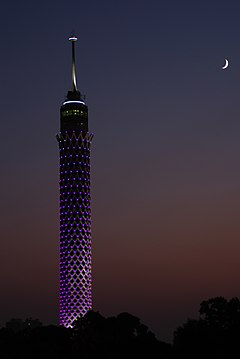Cairo Tower
| Cairo Tower | |
|---|---|
| Arabic: برج القاهرة, Borg Al-Qāhira, | |

2008
|
|
| General information | |
| Type | Communications, observation, restaurants, visitor attraction |
| Location | Cairo, Egypt |
| Coordinates | 30°02′45″N 31°13′28″E / 30.04583°N 31.22444°ECoordinates: 30°02′45″N 31°13′28″E / 30.04583°N 31.22444°E |
| Construction started | 1956 |
| Completed | 1961 |
| Opening | 1961 |
| Cost | $6m |
| Owner | Government of Egypt |
| Height | |
| Antenna spire | 187 metres (614 feet) |
| Technical details | |
| Floor count | 90 |
| Lifts/elevators | 3 |
| Design and construction | |
| Architect | Naoum Shebib |
| Website | |
|
cairotower.net (requires Adobe Flash; in English) |
|
The Cairo Tower (Arabic: برج القاهرة, Borg Al-Qāhira) is a free-standing concrete tower located in Cairo, Egypt. At 187 m (614 ft), it has been the tallest structure in Egypt and North Africa for about 50 years. It was the tallest structure in Africa for 10 years, until 1971 when it was surpassed by Hillbrow Tower in South Africa.
One of Cairo's well-known modern monuments, sometimes considered Egypt's second most famous landmark after the Pyramids of Giza, it stands in the Gezira district on Gezira Island in the River Nile, close to Downtown.
Built from 1954 to 1961, the tower was designed by the Egyptian architect Naoum Shebib. Its partially open lattice-work design is intended to evoke a pharaonic lotus plant, an iconic symbol of Ancient Egypt. The tower is crowned by a circular observation deck and a rotating restaurant with a view over greater Cairo. One rotation takes approximately 70 minutes.
In the 1960s, Egyptian President Gamal Abdel Nasser announced that the funds for the construction of the Tower originated with the Government of the United States, which had provided $6,000,000 to him as a personal gift with the intent of currying his favour. Affronted by the attempt to bribe him, Nasser decided to publicly rebuke the U.S. government by transferring the entirety of the funds to the Egyptian government for use in building the Tower.
Between November 2004 and 17 May 2009 it underwent a EGP 35 million restoration project, completed in time for its fiftieth anniversary on April 2011.
...
Wikipedia
